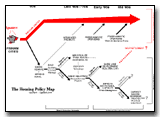|
||||||||||||
|
||||||||||||
|
Larger area issues often affect local issues and vice-versa. Coordination among the levels allows reinforcement, better use of resources, and assures sufficient outside support for upgrading efforts. Characteristics of a ‘good project’ are reviewed in the context of city development initiatives. A housing policy map shows the shifts in thinking and relation of other development programs. Notes on the more recent City Development Strategy, of the World Bank, are shown as an example of city-level planning in which upgrading is coordinated. A summary and example of the Comprehensive Development Framework of the World Bank suggests a structure at the country level. |
||||||||||||
|
|
||||||||||||
What is a “Good” Project? |
||||||||||||
Earl Kessler, Deputy Director, Urban Programs, USAID Global Environment Center. February 2000. Email: Earlkessler@USAID.gov The following is a set of proposed “good project” elements. A “good project” will:
|
||||||||||||
|
|
||||||||||||
Housing Policy Shifts 1950-1900's |
||||||||||||
|
In developing countries, the explosion of population and the subsequent rapid migration to urban areas forced governments to confront an ever-growing squatter phenomenon. Their solutions - encouraged and often lead by international development agencies - followed a relatively clear pattern: from initial removal to direct construction of housing, to eventually macro-economic corrections. At each stage as experience was collected and the initial euphoria of success was not met, policy-makers were confronted with two choices: to improve what they are doing now, or to make a conceptual shift and change radically the approach. For example, there was a conceptual shift in the late 60s from direct housing construction by governments to embracing squatters as the solution and shifting to land development schemes. Note that throughout the years the informal ‘autonomous’ policies’ have overshadowed by far the official ‘formal’ efforts, and it appears that this split is growing in most situations. (See also: ‘Scaling-Up’ and ‘Preventive Measures’) |
||||||||||||

View a housing policy map which shows the shifts in |
||||||||||||
|
|
||||||||||||
City Development Strategy (World Bank) |
||||||||||||
|
The CDS - or Urban Development Strategy as it is sometimes called - is an analytical approach which takes a city and its surrounding region as the unit of planning. At least four aspects of cities are generally examined: livability, competitiveness, good governance and management, and bankability. A CDS engages all city stakeholders in understanding the opportunities and constraints faced by their cities. The process aims to develop a realistic long-term vision for a city, helping to define and prioritize actions needed to achieve goals. Upgrading invariably features prominently in the planning visions. National development programs are moving down to the urban level because of increased emphasis on decentralization and democratization, fiscal reforms, changes in intergovernmental finance, and emphasis on participation in governance. |
||||||||||||
|
|
||||||||||||
The Comprehensive Development Framework (World Bank) |
||||||||||||
|
At its core, the framework focuses on a holistic approach to development, applied over a 10-15 year time-frame, with the country in the driver's seat and with strong partnerships among donors, the private sector and civil society. The proposal also seeks to put the social, structural and human aspects of development on a par with the more traditional macroeconomic analysis of countries - arguing that unless these two sides of the same coin are taken together, only one-half of the development picture is ever seen. (See also: http://www.worldbank.org/html/extdr/cdf/cdf-faq.htm and http://www.worldbank.org/html/extdr/cdf/piloting.htm) |
||||||||||||
|
||||||||||||
| Click on the above framework charts to view a full size example. The examples are in Adobe Acrobat PDF. Adobe Acrobat Reader is free software that lets you view and print Adobe Portable Document Format (PDF) files. Download the latest version. | ||||||||||||
|
||||||||||||


